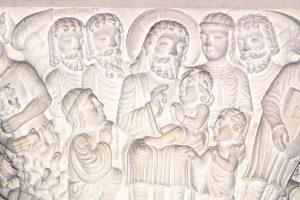A retreat director walked into a bar . . .
This isn’t the start of a joke, but a lead-in to an inspiring conversation. It was Easter Sunday. I was checked into a motel far from home. I’d just offered three retreats in a month’s time. Needless to say, I was beat.
This was an abnormal Holy Week for me. Normally I color Easter eggs and create baskets. I attend Triduum services and am uplifted by the rituals, hymns, and scriptures of these special days. Lenten disciplines give way at last to the payday of rich liturgies. I fall in love with being Catholic again.
But not this year. This year I worked the holy days. Resurrection Sunday found me sleeping the whole day away in a rented bed. I woke up that evening—and was hungry.
Where do you find a restaurant open on Easter? It was too special a night for Burger King. I located a Japanese grill in a strip mall and walked in. A lone blonde woman in a suit sat at the bar, a briefcase heavily occupying the stool next to her. Like me, on a night meant for celebration with family, she was someplace else.
Too tired for conversation, I slid into a booth deeper in the restaurant. A boisterous extended family occupied two long tables pushed together. Otherwise, the place was empty.
The waiter was a pleasant young woman with blue-tinted hair, a nose ring, and fabulously painted silver nails. She took my cocktail order, and I pressed her to take the entrée order at the same time. I was famished. When the food arrived I inhaled it, still waiting for the drink to appear. The waiter was busy with the big family. They were drinking tea, so what was holding up the bartender? One woman on a barstool could hardly keep him occupied the whole time.
Finally I caught the waiter’s eye and asked about my drink. She assured me she hadn’t forgotten to put the order in. Then, smiling, she confided, “Oh, our bartender. He’s on a journey.”
Her reply was so Zen and so un-clarifying I burst out laughing. I had to agree: We’re all on a journey. I wondered if the bartender’s journey might one day intersect with pouring me a drink. It did—shortly before I paid the bill.
This exchange has led to my go-to response to inquiries with unsatisfying answers. When editors want to know why an essay is late, I reply that, you know, I’m on a journey. If friends complain about mutual acquaintances, I counsel patience: Our friends are all on their journeys. When service is slow, coworkers drop the ball, or preachers disappoint, I remind myself that we’re each on a journey that’s unique, multifaceted, and mysterious to anyone but ourselves. We’re not who we used to be, and we’re not who we will be. Life is process. We’ve not yet arrived at the end of our story, so withhold all applause—and all judgment—until the end.
This whimsical exchange in a Japanese bar altered my outlook. I still feel a wave of impatience rise when encountering circumstances or people who don’t deliver on my timetable. Yes, it’s frustrating. But the reality of process remains. It doesn’t explain away human imperfection, but it does remind me of the ways I too disappoint and annoy the people around me. To work with, befriend, or love me means accepting my process. Not everyone will, of course. Which has as much to do with their place in their own process.
Did Jesus, as a human being, undergo a similar process of self-discovery and growth? A definitive answer is beyond our grasp. This ignorance concerning how much divine omniscience Jesus could plug into in his earthly life has never kept scholars, nor the average churchgoing believer, from speculating on the possibilities. What did Jesus know, we wonder, and when did he know it?
This question often arises as we listen to Matthew’s narrative involving Jesus and the Canaanite mother. The encounter Jesus has with this woman always feels like a slap in the face. Her face, that is—and by shared experience, that of many of us attending to this story. Jesus says to her plainly that she doesn’t rate a miracle because she’s not a Jew. It’s not merely a religious distinction being drawn but also an ethnic and tribal one. And it hurts.
It hurts us because at one time or another we’re all defined as outside a category we deeply want or even need to be on the inside of. We don’t merit medical attention because of our bad insurance? We don’t have the same rights because of our sexual orientation or skin color? We don’t get included in a decisive meeting because of our pay grade? We’re sent back to a dangerous situation in our homeland because we don’t have the right papers? We’re not eligible for a sacrament of the church because we’re women?
This Canaanite has a sick daughter who needs a cure. And the one person who can supply it is silent when she pleads for his mercy. After being prompted by his companions to get rid of her, Jesus offers a bald philosophical reason for denying her need. It’s not my wheelhouse. You’re not my clientele.
This desperate mother renews her statement of faith and her plea. Whereupon Jesus makes an even more dismissive remark which, to a dog-despising Semitic audience, sounded far worse than it does to our pet-fawning society. Food is for children; not for dogs.
Three times denied. And three times the mother persists. Her argument is called clever by scholars, but it’s not the witty reply of a dinner companion. This woman isn’t an equal. She has no rights here. Finally, Jesus is impressed by her faith. We may be more impressed by the unshakable claim she asserts on his compassion.
Is Jesus “on a journey”? In this encounter, does he grow in appreciation of his mission? Luke’s gospel states early: “Jesus increased in wisdom and in years” (Luke 2:52). But this woman’s story isn’t told by Luke, nor by John. Mark includes her but describes her more accurately as a Syro-Phoenician. Matthew’s use of the antique term Canaanite is meant to be derogatory and cruel. Matthew also triples the denials the woman faces in the exchange.
In Matthew’s gospel, the journey Jesus is on is regularly punctuated by intersections with Gentiles. Magi visit his infancy (ch. 2). A centurion seeks healing for his servant (ch. 8). A Gadarene demoniac is restored (also ch. 8). On at least two earlier Matthean occasions, then, Jesus performs healings beyond “the house of Israel.” This narrative alone presents Jesus as withholding a healing. Why is this woman treated so miserably?
The shaping of this story is greatly influenced by its intended audience. Matthew’s readers were likely Jewish Christians. They loathed Syro-Phoenician Greeks with the same disgust as Canaanites of old. They likely resented women being received on equal footing with men in the church. Matthew includes this harsh and difficult story to challenge this stubborn audience: Yes, even people you view as dogs have a place in the compassion and restoration of Jesus. So who’s really on a journey here: Jesus or his followers?
This article also appears in the August 2023 issue of U.S. Catholic (Vol. 88, No. 8, pages 47-49). Click here to subscribe to the magazine.
Image: Unsplash/Jan Huber













Add comment